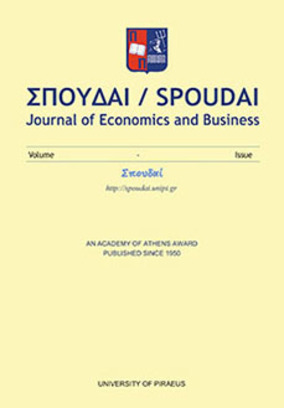Educational stock and economic growth. The case of Greece over the period 1981-2009
Part of : Σπουδαί : journal of economics and business ; Vol.62, No.1-2, 2012, pages 56-71
Issue:
Pages:
56-71
Author:
Abstract:
This paper examines the impact of education on economic growth in Greece over the period 1981- 2009 by applying the model with two sectors introduced by Lucas (1988). The findings of the empirical analysis reveal that there is no long-run relation between educational stock and output. In the short run educational stock has had a statistically insignificant negative effect on economic growth. The econometric model explained 64% up to 72% of the variation of the economic growth rate through the variation of the independent variables. By checking the assumption of scale returns of the model, the results showed that the human capital stock grows but at a decreasing rate, so the endogenous character of the economic growth is not verified.
Subject (LC):
Keywords:
economic growth, education, human capital, Greece, cointegration, Lucas model
Notes:
Περιέχει διάγραμμα, πίνακες και βιβλιογραφία
References (1):
- Abramovitz, M., 1962. Economic Growth in the United Sates, American Economic Review, vol.52, pp. 762-782.Akaike, H. 1974. A new look at the statistical model identification, IEEE Transactions on AutomaticControl, 19 6, pp. 716-723.Ameco database - European Commission. Available at http://ec.europa.eu/economy_finance/ameco/user/serie/SelectSerie.cfm accessed June 2012.Asteriou, D. and Agiomirgianakis, G., 2001. Human capital and economic growth, Time series evidence from Greece, Journal of Policy Modeling, vol. 23, pp. 481-489.Becker, G. S., 1964. Human Capital: A Theoretical and Empirical Analysis, with Special Referenceto Education. New York: Columbia University Press.Benos, N. and Karagiannis, S., 2008. Convergence and economic performance in Greece: evidenceat regional and prefecture level, Review of Urban and Regional Development Studies, vol. 20,No 1, pp. 52-69.Bowles, S., 1971. Growth Effects of Changes in Labor Quality and Quantity, Greece 1951-1961, in:H. Chenery, ed., Studies in Development Planning, Harvard University Press, Cambridge.Bratti, M. and Bucci, A., 2003. Human Capital and International Differences in Income Levels,working paper presented at the workshop ‘Economic Growth and Income Distribution’ inAncona.Caramanis, M. and Ioannides, J., 1980. Sources of growth and the contribution of education, sexand age structure to the growth rate of the Greek economy, Greek Economic Review, vol. 2,pp. 143-162.Denison, E. F., 1967. Why Growth Rates Differ? Washington DC, The Brookings Institution.Dimakos, G., 1996. Education – Productivity, Social and Economic development of Greece, PhDThesis, Department of Economics, National and Kapodistrian University of Athens.El-Mattrawy, K. and Semmler, W., 2006. The Role of Education and Human Capital for EconomicGrowth in Middle Income Countries: Egypt’s Case, working paper DOI:http://www.newschool.edu/cem/eg-role-of-education-egypt-062006.pdfEuropean Commission, 2011. Recent developments in European higher education systems. CommissionStaff Working Document SEC 2011 1063 final.Foldvari, P. and Van Leeuwen, B., 2009. An alternative interpretation of average years of educationin growth regressions, Applied Economics Letters, vol. 16, No 9, pp. 945-949.Gong, G., Greiner, A. and Semmler, W., 2004. The Uzawa-Lucas model without scale effects: theoryand empirical evidence, Structural Change and Economic Dynamics, vol. 15, No 4, pp.401-420.Granger, C. W. J., 1969. Investigating causal relations by econometric models and cross-spectralmethods, Econometrica, vol. 37, pp. 424-438.Granger, C. W. J. 1988. Some recent developments in the concept of causality, Journal of Econometrics,vol. 39, pp. 199-211.Hellenic Statistical Authority. Available at http://www.statistics.gr/portal/ page/ portal /ESYE accessedDecember 2011.Johansen, S., 1988. Statistical Analysis of Cointegrating Vectors, Journal of Economic Dynamic andControl, vol. 12, pp. 231-254.Johansen, S. and Juselius, K., 1990. Maximum likelihood estimation and inference on cointegrationwith applications to the demand for money, Oxford Bulletin of Economics and Statistics,vol. 52, pp.169-210.Kwiatkowski, D., Phillips, P. C. B., Schmidt, P. and Shin, Y., 1992. Testing the Null Hypothesis ofStationarity against the Alternative of a Unit Root. Journal of Econometrics, vol. 54, pp.159-178.Lianos, T. and Milonas, A., 1975. The contribution of production input to the Greek growth rate,1961-1971, Centre for Planning and Economic Research, Athens. [In Greek].Lin, T., 2003. Education, technical progress, and economic growth: the case of Taiwan, Economicsof Education Review, vol. 22, pp. 213-220.Lucas, E., 1988. On the mechanics of economic development, Journal of Monetary Economics,vol. 22, pp. 3-42.Magoula, T. and Prodromidis, K., 1999. Education and economic growth in Greece, DiscussionPaper No. 99, Athens University of Economics and Business.Mankiw, G., Romer, D. and Weil, D., 1992. A contribution to the empirics of economic growth,Quarterly Journal of Economics, vol. 107, pp. 407-437.Mincer, J., 1974. Schooling, Experience and Earnings, Columbia University Press.Monteils, M., 2002. Education and economic growth theory test. The French case, Historical SocialResearch, vol. 27, No 4, pp. 93-107.Monteils, M., 2004. The analysis of the relation between education and economic growth, Compare:A Journal of Comparative and International Education, vol. 34, No 1, pp. 103-115.Newey, W. and West, K. D., 1987. A Simple, Positive, Heteroskedasticity and AutocorrelationConsistent Covariance Matrix. Econometrica, vol. 55, No 3, pp. 703-708.Psacharopoulos, G. and Kazamias, A., 1985. Education and Development in Greece, Ed. NCSR.[In Greek].Romer, P. M., 1986. Increasing Returns and Long-Run Growth, Journal of Political Economy, vol.94, No 5, pp. 1002-1037.Romer, P., 1990. Endogenous technological change, Journal of Political Economy, vol. 98, No 5,pp. 71-102.Schultz, T. W., 1961. Investment In Human Capital, American Economic Review, vol. 51, pp. 1-17.Schwarz, G. E., 1978. Estimating the dimension of a model, Annals of Statistics, vol. 6, No 2, pp.461-464.Smith, A., 1776. The Wealth of Nations, Modern Library 1937.Solow, R. M., 1956. A Contribution to the Theory of Economic Growth, Quarterly Journal of Economics,vol. 70, No 1, pp. 65-94.Solow, R. M., 1957. Technical change and the aggregate production function, Review of Economicsand Statistics, vol. 39, No 3 Aug., 1957, pp. 312-320.Tsamadias, C. and Prontzas, P., 2011. The effect of education on economic growth in Greece overthe 1960-2000 period, Journal of Education Economics, vol. 20, No 5, pp. 522-537.Tsamadias, C. and Pegkas, P., 2012. Τhe effect of education on economic growth in Greece overthe 1981-2009 period. Does the proxy of human capital affect the estimation? InternationalJournal of Education Economics and Development, Vol. 3, No 3, pp. 237-251.Van Leeuwen, B., 2006. The role of human capital in endogenous growth in India, Indonesia andJapan, 1890-2000, International Economic History Conference, August, Helsinki.




